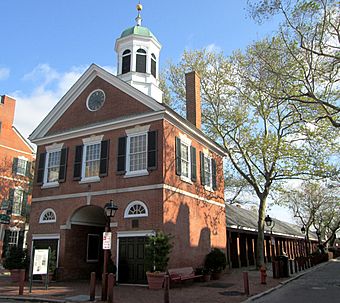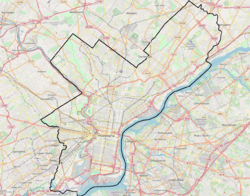New Market and Head House facts for kids
|
New Market
|
|
|
U.S. Historic district
Contributing property |
|

Head House (left) and market sheds (right) (2013)
|
|
| Location | S. 2nd St., between Pine & Lombard Sts. Philadelphia, Pennsylvania |
|---|---|
| Area | 2 acres (0.81 ha) |
| Built | Market: 1745 Head House: 1804 |
| Architectural style | Georgian |
| Part of | Head House Square (ID72001158) |
| NRHP reference No. | 66000686 |
Quick facts for kids Significant dates |
|
| Added to NRHP | November 13, 1966 |
| Designated CP | June 19, 1972 |
The New Market is a very old street market in Philadelphia, Pennsylvania. It is also known as Head House Market or Second Street Market. You can find it on South 2nd Street, between Pine and Lombard Streets. This market has been around since 1745, making it one of the oldest market buildings still standing in the United States.
The part of the market that remains today was named a National Historic Landmark in 1966. It is the main feature of the Head House Square historic area.
History of the Market
The New Market started in 1745 on Lombard Street. It was created by Edward Shippen, who was the mayor of Philadelphia, and Joseph Wharton, a rich merchant. They called it "New Market" to tell it apart from another market on High Street (which is now Market Street).
The market was used a lot throughout the 1800s. It first had 16 stalls. These were made from two rows of brick pillars that held up a roof and an arched ceiling. This open market area was called the Shambles. By 1797, the market stretched all the way to South Street. It even had a firehouse at its end, which was later taken down. Eventually, the market also extended north to Pine Street.
The Head House Building
In 1804, a wealthy merchant and builder named Joseph Wetherill helped the City of Philadelphia build the Head House. This building was placed at the north end of the New Market on Second Street. Wetherill even loaned the city $1,000 to help pay for it.
The Head House is a Georgian-style brick building. It has Federal-style decorations. It was built as a firehouse, and its top part (called a cupola) once held a firebell. This firehouse is the oldest one still standing in the United States. Today, it is used as a community center for people in the area.
The market was at its biggest by 1811, reaching all the way to South Street. The section of the market between Pine and Lombard Streets was fixed up in 1923. During this repair, the roof and many brick pillars were replaced. The Head House building has also been restored over the years.
The New Market was officially named a National Historic Landmark on November 13, 1966. It is also part of the Head House Square National Historic District. A group called the Head House Conservancy, which is a non-profit organization, restored it again in 1994.
Head House Square Area
|
Head House Square
|
|
| Location | Both sides of the 400 block of S. 2nd St., Philadelphia, Pennsylvania |
|---|---|
| Area | 9.9 acres (4.0 ha) |
| Built | 1775 |
| Architect | John Haviland; Van Arkel & Moss |
| NRHP reference No. | 72001158 |
| Added to NRHP | June 19, 1972 |
The area around the New Market building is called Head House Square. It has charming cobblestone streets and a park. It is also home to one of the oldest farmer's markets in the country that has been running without stopping.
The farmer's market is open every Sunday. It runs from the first week of May until the week before Christmas. You can visit from 10 AM to 2 PM to buy fresh, local produce and other farm goods.
The Head House Square area covers about 9.9 acres. It includes 22 important historic buildings. This area was added to the National Register of Historic Places as a historic district in 1972. The houses around the square were built in the late 1700s to early 1800s. They were extensively restored in the 1950s and 1960s.
These houses have always been used as both homes and businesses. Most of them are typical middle-class homes from that time. However, the John Ross House at 401 S. 2nd Street was one of the largest townhouses of its day. Even George Washington visited this house!





